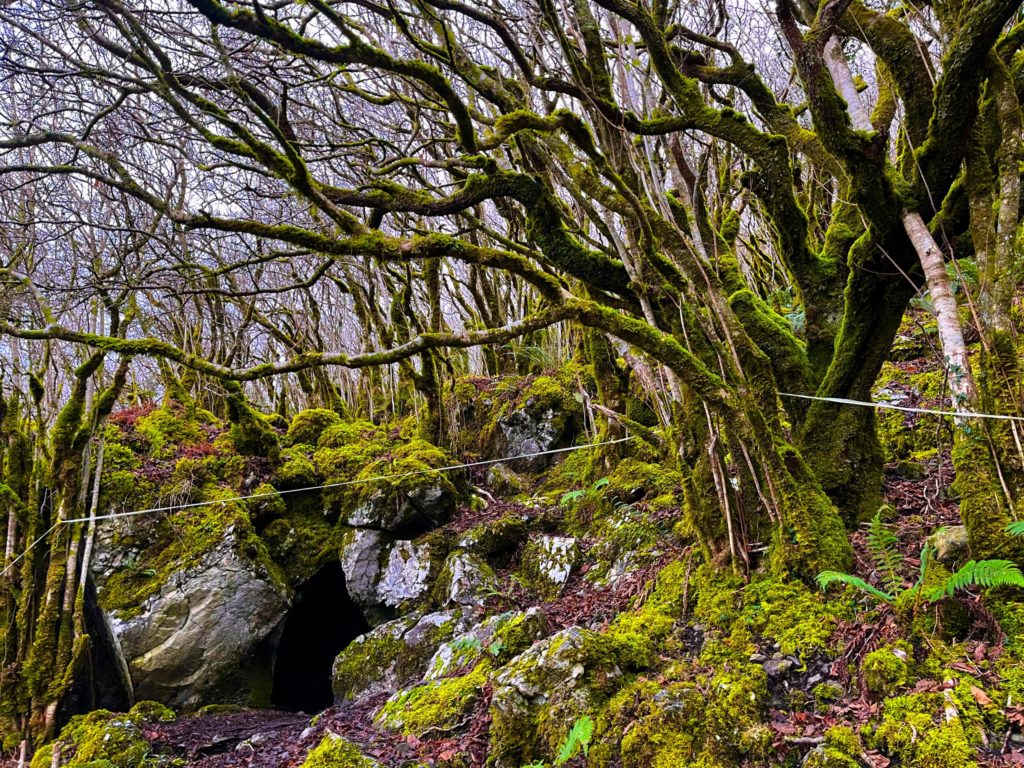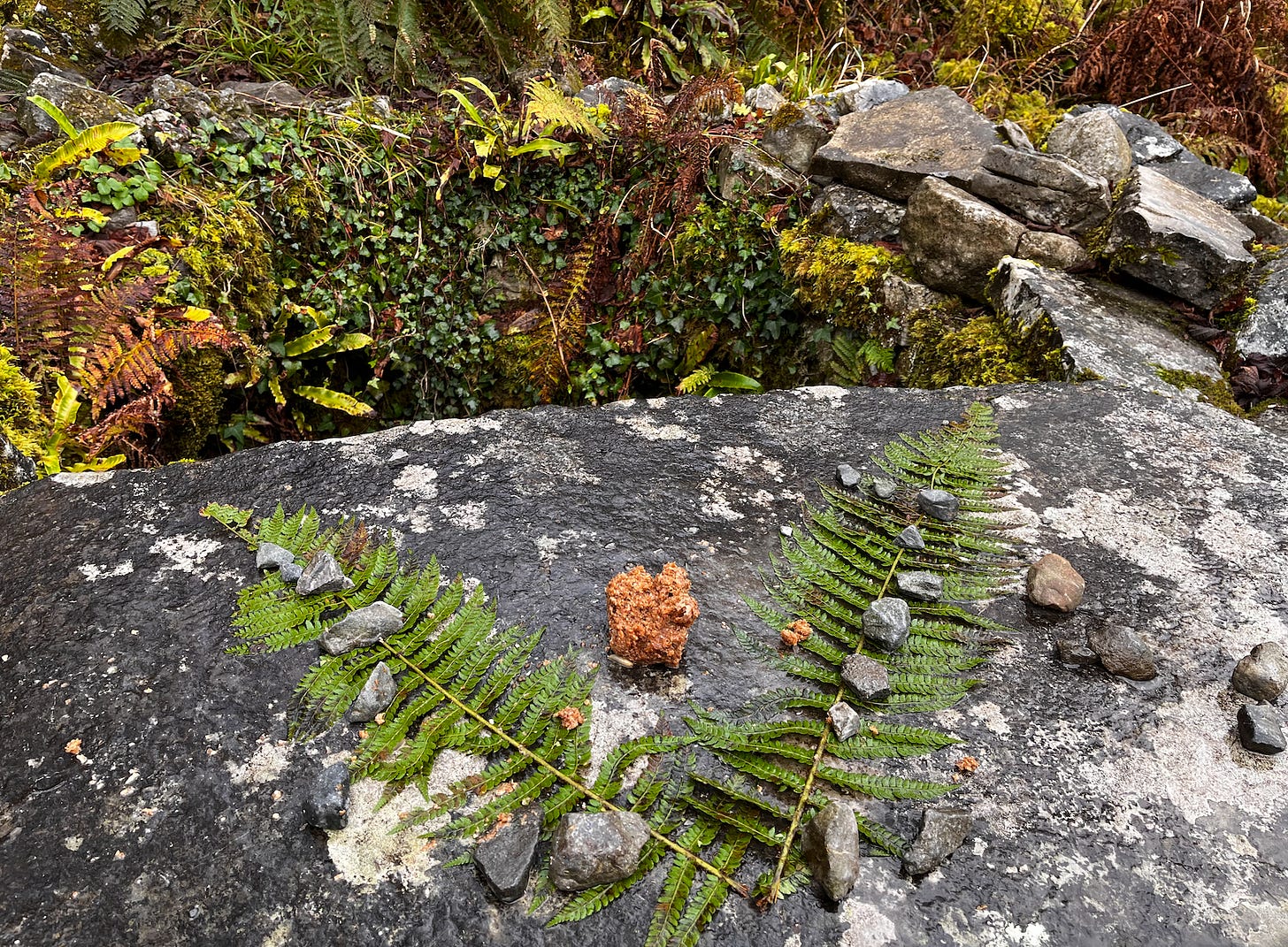In The Cave Of The Irish Hermit

Last week, the writer Paul Kingsnorth took me to visit the cave of St. Colman Mac Duagh, a seventh century abbot, bishop, and wonderworker who lived for seven years in the cave you see above. I sat in the shallow cave alone for about twenty minutes, praying. Here's what it looked like from inside:

It affected me strongly, being there. We had to walk some distance over difficult terrain to get to the cave. I wrote about it last week on my subscriber-only Substack:
We entered the edge of the forest, and I found myself at once in a Tolkienesque atmosphere, in which the moss-covered trees seemed to be watching me, wondering if I could be trusted with the story they had to tell. The tree branches are veiled with brilliant green moss, a sign, Paul tells me, of the purity of the air. I understood immediately why Martin Shaw, after visiting the St. Colman cave, came to believe that he had seen “the mossy face of Christ” there.
We stopped by St. Colman’s Well, which is a natural spring near the cave and the stone ruins of a chapel (which couldn’t have been built by Colman, as the original would have been wooden). We found this by the well, indicating that someone had left some kind of offering of brown soda bread, and an arrangement of greenery and stones:

“Fairy food,” said Paul. “We’d better leave it alone.”
He means that whoever preceded us there must have left this as an offering for the little people. Whether Paul believes in their existence, I don’t know. But I agree with him that even if it is merely symbolic, it’s wise not to mess with it. This is enchanted territory. Someone meant it for good; best to respect them.
And then, up a muddy path, was the cave...
For me, coming from Louisiana, the forest of St. Colman was Edenic. Ireland is like a cooler version of my home state, which is a damp, green place. But there are no serpents in Ireland. I never would have gone into a cave in Louisiana, for fear of poisonous snakes. Ireland is like Louisiana before the fall. What an unusual and welcome thing to feel at home in Nature.
I was visiting Paul in rural County Galway to interview him for my upcoming book on re-enchantment. We had been talking about how Ireland seems to be a "thin" place, a place where the numinous seems especially near. Lo, I see now that Paul has just published a big essay in First Things about St. Colman and "cave Christianity". Check out these excerpts:
I can’t remember when I first came to Colman’s cave with my family, on a weekend walk, but since then I’ve been unable to stop myself returning. There is something about this place, more than any other holy site in a land still stippled with them, that pulls me in. Five years ago I walked from my front door to the cave, carrying a tent and sleeping bag and visiting every holy well I could find on the way, a solitary journey that took me three days. I slept in the cave back then too, and again it rained on me. I was a pagan in those days, a practitioner of Wicca trying to get to know the “old gods” of the land, but it wasn’t lost on me even as I did so that I had basically designed for myself a Christian pilgrimage. Probably, of course, I hadn’t designed it at all. Five years later I found myself back in the cave in the rain, this time as a baptized Orthodox Christian. My Christian journey so far has taught me two cataphatic lessons: that God is an artist; and that he has a sense of humor.
What is it that draws me to people like Colman? I have, since a young age, been strangely obsessed by hermits, mystics, and their kind. Maybe Gandalf started it. He may be a global celebrity now, but Tolkien designed him as a version of an archetype that can be traced back in my own country to the high god of the Anglo-Saxons, Woden, also known as Grim. Woden, unlike his Norse corollary Odin, was something of a hermit himself. He was often to be found wandering the high downs alone, staff in hand, wide-brimmed hat on his white-haired head, his familiars—a raven and a wolf—by his side. Woden had only one eye, but it could see directly into the soul of anyone unfortunate enough to encounter him up on the Ridgeway on a blustery autumn day.
Maybe this sort of thing is in my blood, or maybe I just read too many fantasy novels. Or perhaps it’s something else entirely. All I know is that the retreat to the wilds to find wisdom is a story I have returned to again and again throughout my life, and one in which I have participated on more than one occasion. On most of those occasions I was far from being a Christian. But then Christians are far from being the only people who retreat to the woods to seek God or the truth, which always turn out, in the end, to be the same thing. The retreat to the cave, often followed by a return to the world, is an underworld journey. That journey will be undertaken by all of us at some point in our lives, whether we want it or not. Recently I’ve begun to see that it’s a journey that must also be undergone sometimes by entire cultures.
More:
I have a feeling that the cave Christians may prove to be our future as well as our past. Sometimes you need to refresh yourself at the spring; you need to hunt for the source of what gives you life, when the outward structures of your world visibly creak and shiver. And the source of our Christianity in these islands, or one of the sources, is the cave Christians: the wild saints.
I'm not a Nature Lover like Paul is (then again, I don't know if I have any friends who love Nature like Paul does). Still, I am powerfully attracted to saints like Colman, and was delighted to be surprised by how at home I felt in his wet, mossy forest, and in his damp cave. In my view, what cave hermits like Colman stand for is the most radical form of the Benedict Option. I trust that I don't have to explain that to you. In the Ben Op, for lay persons, the idea is to withdraw more substantially from the world, so that when we live in the world (as we must), we can live there faithfully, because we will have strengthened our faith with deeper prayer, study, community, and worship. The hermit, though, leaves the world entirely.
What, then, does the hermit have to say to us? This: that we have to learn to desire God so much that we would sacrifice everything for Him. Very, very few of us would actually be able to go live in a cave and eat nuts and berries as part of a radically ascetic program of dying to self to live in Christ. Only few are called by God to that kind of life. But what monks and nuns do, and especially what hermits do, is a model. I brought back a rock from inside Colman's cave. I put it on my icon shelf, and have been asking him in my daily prayers to intercede for me, that I will desire union with God even a fraction of the way that he did. That all-consuming desire for God -- that is the source of what gives us life, or rather, keeps us pushing through the calamities and confusion, through to Him.
When I sat on the rock shelf inside St. Colman's cave, praying, I didn't have any mystical sensations, nothing like that (though the English writer Martin Shaw did begin having powerful dreams after his visit there with Paul, dreams that led him to convert to Christianity -- and indeed Orthodox Christianity). But what I did feel was the immense depth of the Christian faith, and how very far is the experience of a man like Colman from our comfortable middle class Christian way of life. We are going to need what Colman had to get us through what's coming. In the interview I did with Paul for the book, he talked about how the Catholic Church in Ireland is a shambles now, and how none of the younger generation looks to it for direction or inspiration. But, says Paul, you cannot take away from the Irish the experiences and the example of their monks and nuns and hermits. They were Catholic (and Orthodox -- the Church was one back then), and they still speak to us now -- if we are prepared to listen.
One thing I love about Orthodox Christianity is it still cherishes its hermits. Look at this: a YouTube series of interviews with Father Lazarus El-Anthony, an Australian Coptic hermit who lives in the Egyptian desert: